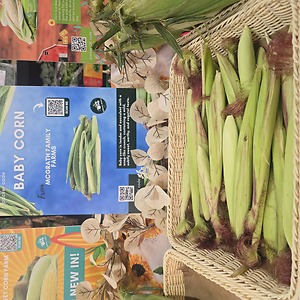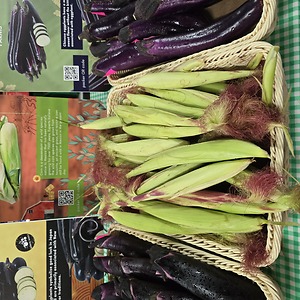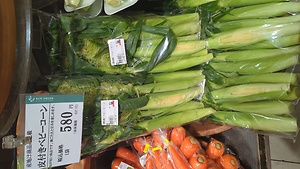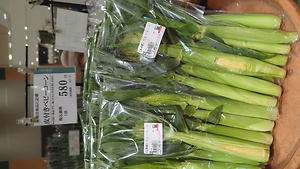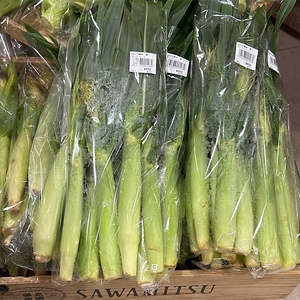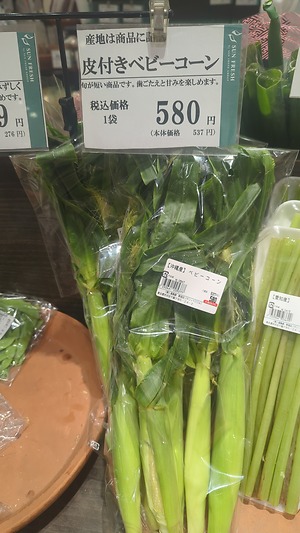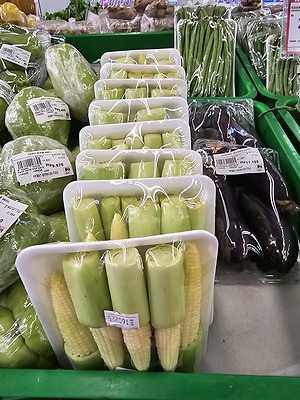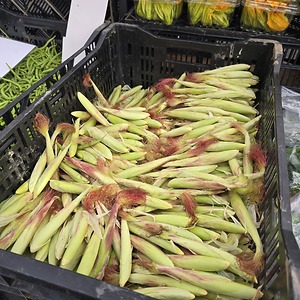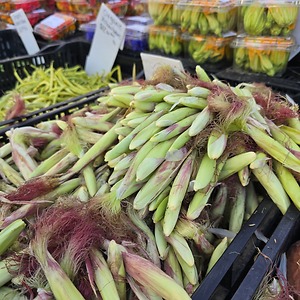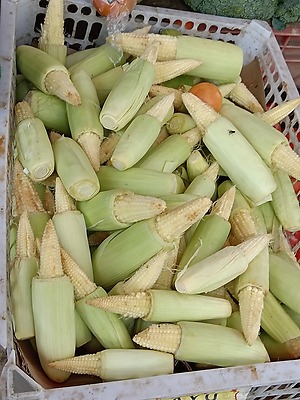


Baby Corn
Estimated Inventory, 100 ct : 6.70
This item was last sold on : 07/17/25
Description/Taste
Baby corn is small, averaging 1 to 2 centimeters in diameter and 4 to 10 centimeters in length, and has a straight and slender cylindrical shape with slight tapering toward the ends of the ear. When sold fresh, Baby corn can be found encased in its green husk, or it can be sold shucked. The cobs are covered in tiny developing kernels, generally pale yellow to cream-colored, and the kernels are arranged in straight, vertical rows. Unlike mature corn, Baby corn is entirely edible, and the cobs have a somewhat flexible nature. Baby corn is tender and succulent with a snap-like crunch, containing a mild, subtly sweet, earthy, and vegetal taste.
Seasons/Availability
Baby corn is available year-round in canned form. When fresh, it has a peak season in the spring and summer.
Current Facts
Baby corn, botanically classified as Zea mays, is a general descriptor used to encompass any variety of corn that has been harvested young before fertilization. The developing ears are picked a couple of days after the corn silks appear, and each ear is hand-harvested to protect its delicate nature. Baby corn is considered a novelty ingredient utilized primarily for added texture, able to provide crunch without overpowering flavors within a dish. The small ears also contribute visual interest to dishes. When commercially grown, Baby corn has a similar flavor profile no matter the corn variety used, as the immature ears have not developed high starch or sugar levels, maintaining a consistent, neutral flavor. Many different types of corn can be used to produce Baby corn, and some farmers use the same crop for both baby and mature ears. Scientists have also developed hybrid varieties with increased yields that are specifically designed for Baby corn cultivation. Baby corn is available fresh in Asia, but in other regions of the world, including the United States, the corn is mainly imported in canned form. Production of Baby corn is labor-intensive and cannot be mechanized, driving up costs. The young ears also have a short shelf life, prohibiting them from being shipped fresh.
Nutritional Value
Baby corn is a source of fiber to regulate the digestive tract and also contains lower amounts of phosphorus to strengthen bones and teeth. While mature corn is nutritionally dense, Baby corn is harvested before the ears can fully develop its vitamin and mineral content. Baby corn is known to contain less sugar than mature corn varieties.
Applications
Baby corn has a neutral, subtly sweet, and vegetal flavor well suited for fresh and cooked preparations. The way the corn is prepared is primarily determined by whether the Baby corn is fresh or canned. Fresh Baby corn can be added to green salads for added crunch, or it can be served with creamy dips as an appetizer. It can also be tossed into soups, curries, and stews, boiled or steamed and mixed into rice or noodle dishes, or stir-fried with other vegetables and meat as a fresh entrée. Baby corn is primarily used to add crunch and texture rather than flavor, and the bumpy surface of the corn catches sauces for depth of flavor. The small ears can also be fried or grilled as finger food or pickled to develop a tangy, fermented taste. In addition to fresh Baby corn, canned Baby corn can also be used in the preparations mentioned above, but the corn will have a softer texture, losing the fresh version’s snap-like crunch. Baby corn pairs well with bell peppers, peas, broccoli, cauliflower, meats such as pork, poultry, and beef, seafood, tofu, herbs such as parsley, basil, and cilantro, and spices including cumin, garam masala, curry powder, turmeric, paprika, garlic, and ginger. Fresh Baby corn does not hold up to shipping and will only keep for 3 to 4 days when stored in the refrigerator. The ears can also be preserved in water and citric acid, pickled, or frozen for extended use. Canned Baby corn generally has a shelf life of 1 to 3 years.
Ethnic/Cultural Info
Baby corn is a favored niche market crop cultivated in India, sold fresh in local markets, and canned for export. In Asia, Thailand has traditionally been known as one of the largest growers and exporters of Baby corn, but in the late 1990s, rural farmers in India began producing Baby corn realizing its potential as a profitable crop. The production of Baby corn also provides many jobs for agriculture-based families, and the baby ears are produced in regions including Western Uttar Pradesh, Punjab, Gujarat, Andhra Pradesh, Maharashtra, and Meghalaya. Baby corn is generally harvested 45 to 50 days after sprouting, and the ears are hand-harvested to protect their delicate nature. Once harvested, Baby corn is immediately processed and preserved in cans, sold to restaurants, or is brought to local markets for consumer sale. In India, Baby corn is popularly incorporated into masala, curries, or stir-fries, or it can be deep-fried and served as a crunchy snack. The small cobs are also commonly pickled and served as a side dish, topping, or appetizer, or they can be chopped into chutney. In addition to the edible cobs, Baby corn silks and greens are utilized as natural cattle feed, reducing waste in the production process.
Geography/History
Baby corn is the young version of many different corn varieties, all of which were created from a wild species native to Mexico, growing wild for over 7000 years. Throughout Mexico, corn was domesticated by indigenous Mesoamericans in prehistoric times and was a staple culinary ingredient. In the 15th century, corn was brought from Mexico to Europe and the rest of the world through explorers, and since its evolutionary spread, corn has become one of the most cultivated crops worldwide. While mature versions of corn are widely available, Baby corn has remained a specialty crop and is widely cultivated and consumed in Asia. The small ears are primarily produced in China, Thailand, Taiwan, India, and Indonesia, where they are sold fresh and canned. Baby corn is also cultivated in Zambia, Kenya, and Zimbabwe, and the ears are processed, preserved, and canned for export to Europe, the United States, and Australia. In the United States, Baby corn is not commonly sold fresh and can only seasonally be found through farmer’s markets, select online retailers, and specialty grocers. It is most commonly canned and sold in supermarkets and big-box retailers.
Featured Restaurants
Restaurants currently purchasing this product as an ingredient for their menu.
| Lafayette Hotel - Lou Lou's | San Diego CA | 619-296-2101 |
| US Grant Hotel Grill | San Diego CA | 619-232-3121 |
| Starlite Kitchen | San Diego CA | 619-358-9766 |
| Mission Pacific | Oceanside CA | 760-450-7864 |
| Pacific Yacht Agents | Los Angeles CA | 808-214-0970 |
| Lauberge Del Mar | Del Mar CA | 858-259-1515 |
| Lilo | Carlsbad CA | 619-385-0914 |
| Kingfisher | San Diego CA | 619-861-8074 |
| C 2 C | San Diego CA | 619-972-9345 |
| Huntress | San Diego CA | 619-955-5750 |
| Stake Chophouse & Bar | Coronado CA | 619-522-0077 |
| Stone Brewing World Bistro & Gardens | Escondido CA | 915-861-2297 |
| Kinme (Deliver to Azuki) | San Diego CA | 619-238-4760 |
| Kinme Omakase | San Diego CA | 619-231-0700 |
| Sushi Ota 2021 | San Diego CA | 858-270-5047 |
| Red O Restaurant (Bar) | San Diego CA | 858-291-8360 |
| Lafayette Hotel - Beginners Diner | San Diego CA | 619-296-2101 |
Recipe Ideas
Recipes that include Baby Corn. One



